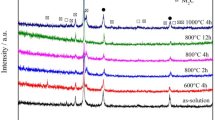Abstract
The spinodal composition zone in Al added Fe-Mn-Al-C twinning-induced plasticity (TWIP) steels can be determined by contents of Al and C and aging temperature together, based on the thermodynamic analysis. Precipitation of ordered (FeMn)3AlC carbide by the mechanism of spinodal decomposition occurs in the C-rich and Al-rich zone with low aging temperature. Increase of aging temperature shrinks spinodal composition zone to the high Al and C contents. As a result, the precipitation of (FeMn)3AlC carbide alters from spinodal decomposition to classical nucleation-growth manner gradually. Further calculation indicates that the diffusion of Al can play a key role in determining the growth rate of (FeMn)3AlC carbide at high aging temperature.
Similar content being viewed by others
References
KIM H, SUH D W, KIM N J. Fe-Al-Mn-C lightweight structural alloys: A review on the microstructures and mechanical properties [J]. Science and Technology of Advanced Materials, 2013, 14(1): 1–11.
WANG C S, HWANG C N, CHAO C G, et al. Phase transitions in an Fe-9Al-30Mn-2.0C alloy [J]. Scripta Materialia, 2007, 57(6): 809–812.
CHOO W K, KIM J H, YOON J C. Microstructural change in austenitic Fe-30. 0wt%Mn-7. 8wt%Al-1. 3wt%C initiated by spinodal decomposition and its influence on mechanical properties [J]. Acta Materialia, 1997, 45(12): 4877–4885.
HAN K H, CHOO W K. Phase decomposition of rapidly solidified Fe-Mn-AI-C austenitic alloys [J]. Metallurgical Transactions A, 1989, 20(2): 205–214.
KIMURA Y, HAYASHI K, HANDA K, et al. Microstructural control for strengthening the α-Fe/E21-(Fe, Mn)3AlCx alloys [J]. Materials Science and Engineering A, 2002, 329/330/331(6): 680–685.
ARDELL A J, NICHOLSON R B. On the modulated structure of aged Ni-Al alloys: With an appendix on the elastic interaction between inclusions by J. D. Eshelby [J]. Acta Metallurgica, 1966, 14(10): 1295–1309.
RIOJA R J, LAUGHLIN D E. The early stages of GP zone formation in naturally aged Al-4wt pct Cu alloys [J]. Metallurgical Transactions A, 1977, 8(8): 1257–1261.
JING Y J, LI C R, DU Z M, et al. The thermodynamic analysis of Guinier-Preston zones in aged supersaturated Al-Cu alloys [J]. Computer Coupling of Phase Diagrams and Thermochemistry, 2008, 32(1): 164–170.
JIANG B H, WAGNER R. TEM study of modulated structure during initial transformation in Ni-Cu-x (x = Si, Cr) alloys [J]. Acta Metallurgica Sinica, 1986, 22(6): 52–57 (in Chinese).
JIANG B H, ZHANG M H, WEI Q, et al. Thermodynamic criterion of spinodal decomposition in ternary systems [J]. Acta Metallurgica Sinica, 1990, 26(5): 303–309 (in Chinese).
DINSDALE A T. SGTE data for pure elements [J]. Computer Coupling of Phase Diagrams and Thermochemistry, 1991, 15(4): 317–425.
TANAKA T, AARONSON H I, ENOMOTO M. Calculations of phase boundaries in Fe-C-X1-X2 systems from the central atoms model [J]. Metallurgical and Materials Transactions A, 1995, 26(3): 535–545.
SIGWORTH G K, ELLIOTT J F. The thermodynamics of liquid dilute iron alloys [J]. Metal Science, 1974, 8(1): 298–310.
ZHANG G H, WEI R, ENOMOTO M, et al. Growth kinetics of proeutectoid ferrite in Fe-0. 1C-1. 5Mn-1Si quaternary and Fe-0. 1C-1. 5Mn-1Si-0. 2Al quinary alloys [J]. Metallurgical and Materials Transactions A, 2012, 43(4): 833–842.
JERZAK W, KALICKA Z. Activity coefficients of manganese, silicon and aluminum in iron, nickel and Fe-Ni alloys [J]. Archives of Metallurgy and Materials, 2010, 55(2): 441–447.
CAHN J W. Spinodal decomposition [J]. Transactions of the Metallurgical Society of AIME, 1968, 242(1): 166–180.
HU G X, CAI X, RONG Y H. Fundamentals of materials science [M]. Shanghai: Shanghai Jiao Tong University Press, 2011: 151 (in Chinese).
HE Z P, HE Y L, GAO Y, et al. Computer simulation of Fe-Al-Si system diffusion couples [J]. Journal of Materials Science and Technology, 2011, 27(8): 729–734.
Author information
Authors and Affiliations
Corresponding author
Additional information
Foundation item: the National Natural Science Foundation of China (No. 51371117)
Rights and permissions
About this article
Cite this article
Yang, L., Huang, F., Guo, Z. et al. Investigation on the formation mechanism of ordered carbide (FeMn)3AlC in the Al added twinning-induced plasticity steels. J. Shanghai Jiaotong Univ. (Sci.) 21, 406–410 (2016). https://doi.org/10.1007/s12204-016-1739-7
Received:
Published:
Issue Date:
DOI: https://doi.org/10.1007/s12204-016-1739-7
Keywords
- twinning-induced plasticity (TWIP) steel
- (FeMn)3AlC carbide
- spinodal decomposition
- thermodynamics
- diffusion




